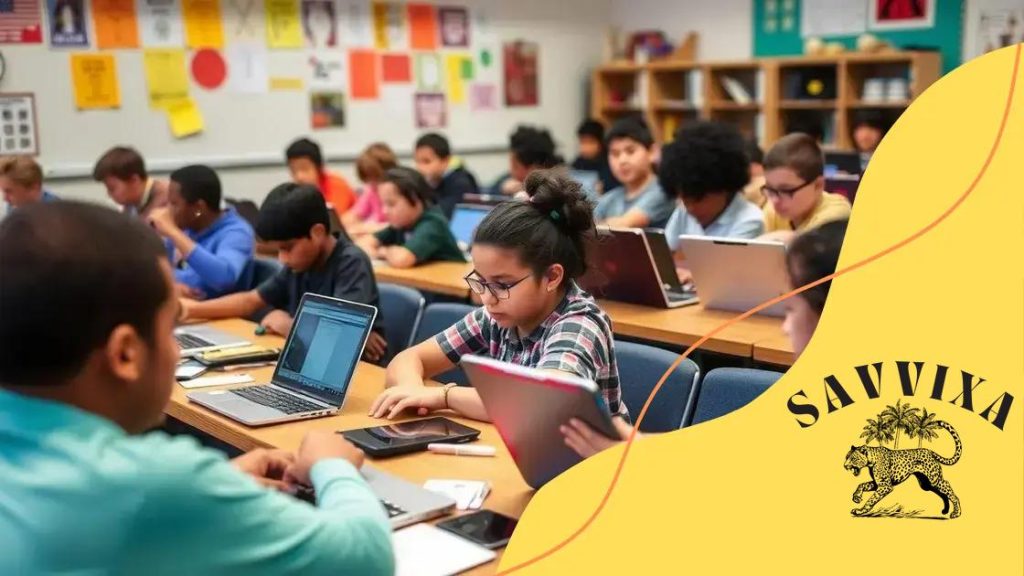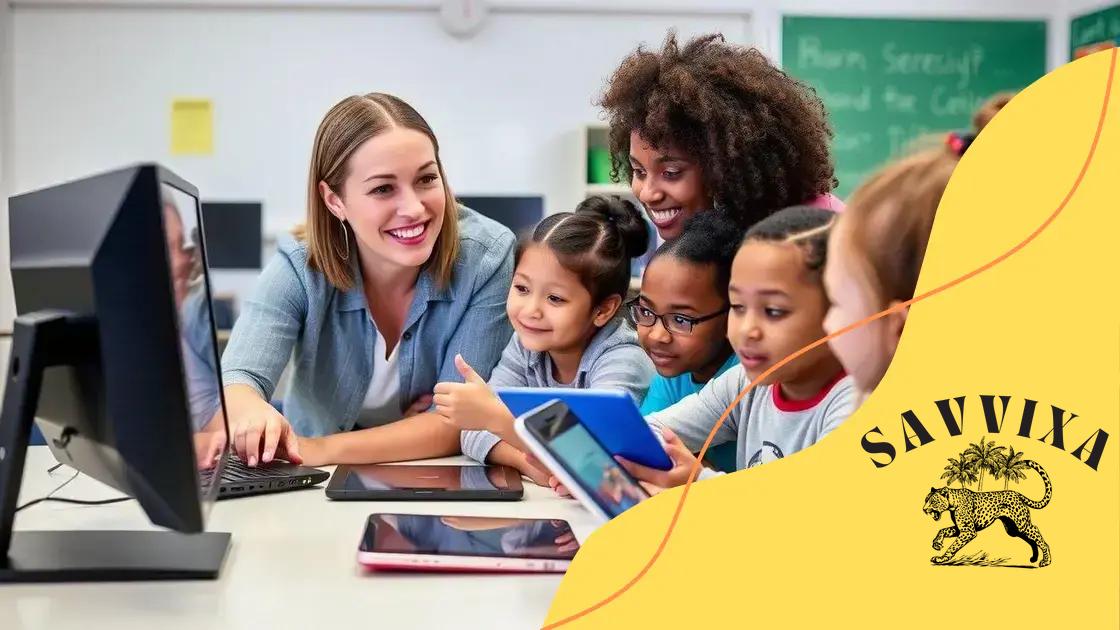Digital literacy as a core curriculum in schools

Digital literacy as a core curriculum in schools equips students with essential skills for thriving in a technology-driven world, promoting critical thinking, collaboration, and adaptability.
Digital literacy as a core curriculum in schools is becoming increasingly vital in our tech-driven world. Have you considered how these skills can shape students’ futures? Let’s dive into the importance of this curriculum.
Understanding digital literacy in education
Understanding digital literacy in education is crucial for preparing students for a rapidly changing world. In this digital age, being literate goes beyond reading and writing. It includes the ability to navigate and use technology effectively.
What is Digital Literacy?
Digital literacy involves a range of skills. It means knowing how to search for information online, evaluate the reliability of sources, and use digital tools for various tasks. Students must learn to communicate and collaborate using technology.
Key Components of Digital Literacy
- Understanding how to use different types of technology.
- Recognizing the importance of online safety and privacy.
- Ability to create digital content.
- Evaluating online information critically.
Schools play an essential role in fostering these skills. By integrating digital literacy into the curriculum, educators can help students become responsible digital citizens. This includes teaching them about ethical behavior online and respecting intellectual property.
As technology continues to evolve, digital literacy will become even more critical. Students will need to adapt and learn new tools throughout their lives. Therefore, digital literacy education should not just be a one-time lesson; it must be a continuous part of their learning experience.
Benefits of integrating digital literacy in schools
Integrating digital literacy in schools offers numerous benefits that can enhance the learning experience. This approach prepares students for a future where technology is essential. It supports their ability to engage with information critically and use digital tools effectively.
Enhancing Critical Thinking
One of the primary benefits of digital literacy is that it promotes critical thinking. Students learn to assess the reliability of online information, helping them develop informed opinions. They become savvy consumers of digital content.
Fostering Collaboration and Communication
When students engage with digital literacy, they also improve their communication skills. Working on group projects using digital platforms helps students collaborate efficiently. They learn how to express their ideas clearly and work together towards common goals.
- Increased engagement through interactive learning.
- Improved teamwork and problem-solving skills.
- Ability to share knowledge and resources easily.
Additionally, integrating digital literacy prepares students for the workforce. Today’s jobs often require the use of technology, and early exposure ensures they are ready to handle these expectations. When students are equipped with these skills, they are more adaptable to various environments, whether in further education or their careers.
Furthermore, digital literacy fosters creativity. Students can create content, from presentations to videos, which encourages them to think outside the box. This creative outlet is essential in developing well-rounded individuals.
Practical strategies for teaching digital skills

Implementing practical strategies for teaching digital skills is essential in today’s classrooms. Teachers can create engaging lessons that help students become proficient in using technology. These strategies support hands-on learning and encourage collaboration among students.
Utilize Collaborative Projects
One effective way to teach digital skills is through collaborative projects. Group activities allow students to work together while using different digital tools. They can create presentations, share files, and provide feedback using platforms like Google Drive or Microsoft Teams.
Incorporate Real-World Applications
Integrating real-world applications into lessons makes digital literacy relatable. For example, students can learn coding by designing a simple app or website. This approach keeps lessons interesting and shows students the practical value of these skills.
- Use online resources for learning coding.
- Encourage students to create blogs or vlogs.
- Implement projects that involve data analysis using spreadsheets.
Another strategy is to provide guided tutorials. Teachers can create step-by-step guides on various digital tools, such as how to use Google Docs or conduct effective online research. These tutorials can be shared on a classroom website or learning management system.
Integrating gamification into lessons can enhance engagement. Tools like Kahoot! or Quizlet encourage students to learn through play. These platforms make digital skill development fun and competitive, motivating students to improve.
Challenges in implementing digital literacy curriculum
Implementing a digital literacy curriculum comes with its own set of challenges that schools must navigate. Addressing these obstacles is crucial for fostering an environment where students can thrive in a digital world.
Lack of Resources
One major challenge is the lack of resources. Many schools struggle with limited budgets, which affects their ability to acquire the necessary technology, software, and training for teachers. This scarcity can hinder the effective delivery of digital literacy programs.
Teacher Training
Another significant hurdle is inadequate teacher training. Educators may feel unprepared to teach digital skills if they do not receive proper professional development. Continuous training is essential for teachers to stay updated with the latest technology and teaching methods.
- Providing hands-on workshops for teachers.
- Encouraging collaborative learning among staff.
- Offering online courses to improve their digital skills.
Additionally, there can be resistance to change from both educators and parents. Some may worry that too much emphasis on technology could diminish traditional teaching methods. It’s important to communicate the benefits of digital literacy and show how it complements existing curricula.
Furthermore, addressing diverse student needs can be challenging. Not all students learn at the same pace, and some may require additional support to develop their digital skills. Tailoring the curriculum to meet these varied needs ensures that every student can benefit.
Future trends in digital literacy education
The future of digital literacy education is evolving rapidly as technology continues to advance. Schools must stay ahead to prepare students for a world that increasingly relies on digital skills. Innovative approaches are reshaping how these skills are taught.
Integration of Artificial Intelligence
One future trend is the integration of artificial intelligence in education. AI can personalize learning experiences, adapting to each student’s pace and needs. This technology has the potential to enhance the teaching of digital skills by providing tailored resources and feedback.
Emphasis on Coding and Computational Thinking
As our world becomes more tech-driven, there will be an even greater emphasis on coding and computational thinking. Schools are beginning to introduce programming as part of the core curriculum. This will help students understand the mechanics behind digital tools and foster innovation.
- Curriculums will include more hands-on coding activities.
- Students will participate in competitions like hackathons.
- Collaboration with tech companies for real-world projects.
Additionally, the importance of digital citizenship will continue to rise. Schools will focus on teaching students how to navigate the online world safely and responsibly. Discussions about privacy, security, and ethics in technology will become standard components of digital literacy programs.
Moreover, blended learning environments will gain popularity. Combining traditional teaching methods with online resources creates a more dynamic learning experience. This approach allows for flexibility and supports different learning styles, helping more students succeed in acquiring digital skills.
FAQ – Frequently Asked Questions about Digital Literacy in Education
What is digital literacy and why is it important?
Digital literacy refers to the skills needed to effectively navigate and use technology. It is crucial for success in today’s tech-driven world.
How can schools integrate digital literacy into their curriculum?
Schools can integrate digital literacy by incorporating technology in lessons, providing hands-on projects, and offering training for teachers.
What are some challenges faced when implementing a digital literacy curriculum?
Challenges include limited resources, inadequate teacher training, and resistance to change from students and parents.
What are the future trends in teaching digital literacy?
Future trends include the use of artificial intelligence, a focus on coding, and an emphasis on digital citizenship to prepare students for a digital future.